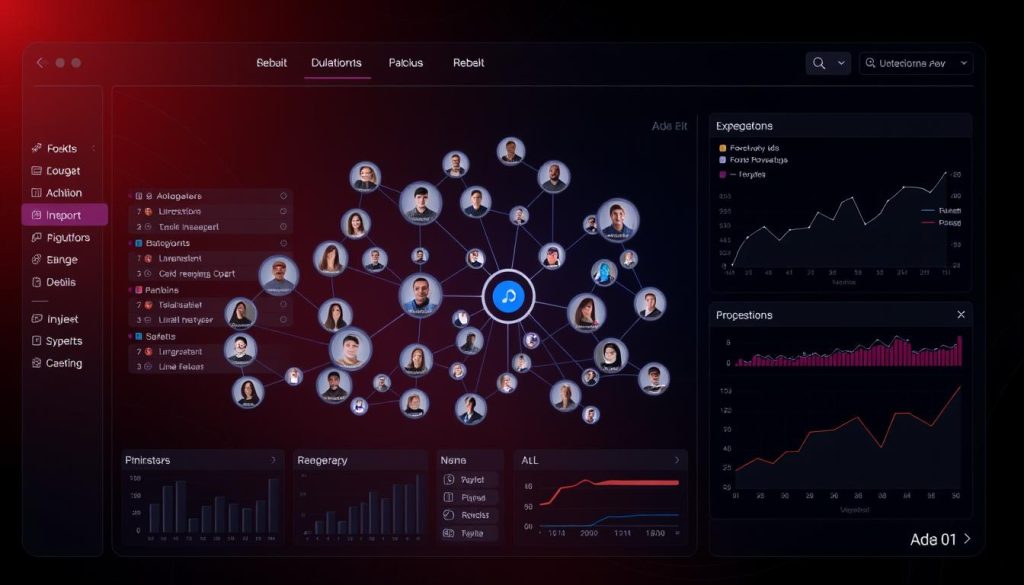In today’s financial world, hedge fund managers must attract investors. Cold emails are key in this effort. They help fund managers grab the attention of potential investors, opening new doors.
Communicating with investors is crucial for building trust. Hedge fund emails should highlight the fund’s unique value and success. These emails are the first chance to make a good impression, so they must be both informative and persuasive.
Mastering cold emailing for capital raising means knowing what investors want and what’s trending. By making emails personal and strong, fund managers can start important conversations. This can lead to real investment opportunities.
Key Takeaways
- Cold emails are essential for hedge fund capital raising
- Personalization is key in investor relations communications
- Compelling fundraising pitch emails can open doors to new opportunities
- Tailored messages increase the chances of attracting potential investors
- A strong investment thesis is crucial for successful capital raising efforts
Understanding the Hedge Fund Capital Raising Landscape
The world of hedge fund capital raising is complex. It involves using private equity acquisition email tips and deal sourcing strategies. Fund managers must move quickly in a changing market while following strict rules.
Current Market Dynamics in Fund Raising
Today, raising funds means knowing what investors want. Big investors want clear information and steady results. Hedge funds must change their plans to fit these needs. They use advanced tools to show their worth.
Key Stakeholders in the Investment Process
The investment process has many players:
- Fund managers: They plan and carry out investment plans
- Institutional investors: They bring in a lot of money
- High-net-worth individuals: They invest privately
- Placement agents: They help funds find investors
Talking well with these groups is key to getting funds. Using private equity acquisition email tips can help send the right message to each group.
Regulatory Considerations for Email Communications
Rules are tight for emails in hedge fund raising. The SEC watches over marketing emails to stop scams and protect investors. Managers must make sure their emails follow the law on what they can say and how they can ask for money.
“In the world of hedge fund capital raising, compliance is not just a legal necessity—it’s a competitive advantage.”
Knowing the key parts of the hedge fund raising world helps managers. They can make their strategies better and have a better shot at success in this tough market.
Essential Components of an Effective Fundraising Email Strategy
Creating a winning fundraising email strategy for hedge funds needs careful planning. Focus on key elements to make investor relations communications hit home with potential backers.
- Clear and concise messaging
- Personalized content for each investor
- Compelling subject lines that grab attention
- Targeted follow-up sequences
Timing is everything in email outreach. Send messages when people are most likely to open them. Analyze your audience to find the best times.
It’s vital to tailor content for different investor types. Family offices, institutional investors, and high-net-worth individuals have unique needs. Customizing your approach boosts engagement and conversion rates.
| Investor Type | Key Focus Areas | Preferred Communication Style |
|---|---|---|
| Family Offices | Long-term wealth preservation | Detailed, relationship-focused |
| Institutional Investors | Risk-adjusted returns, compliance | Data-driven, formal |
| High-Net-Worth Individuals | Exclusive opportunities, personal touch | Concise, emphasizing unique value |
By using these elements in your fundraising email strategy, you can make a big impact. Your investor relations communications will drive results and build strong relationships with potential backers.
Hedge Fund Capital Raising Email Ideas
Writing effective emails is key for raising capital in hedge funds. A good email can lead to a meeting, while a bad one might get ignored. Let’s look at some strategies to improve your outreach.
Personalization Techniques for Investor Outreach
Customizing your message for each investor shows you’ve done your homework. Look into their past investments and what they like. Talk about how your fund matches their interests. This personal touch can really help.
Subject Line Optimization Methods
Your subject line is your first chance to impress. Keep it short, interesting, and to the point. Don’t use generic phrases like “Investment Opportunity.” Try something like “Exclusive Access: Our Latest Fund Performance.” Use A/B testing to find what works best.
Email Body Structure and Flow
Make your email easy to scan. Start with a brief intro, then talk about your fund’s success and strategy. End with a clear call-to-action, like setting up a call or reviewing your investment thesis. Remember, your email is just the start of a conversation, not the whole process.
| Email Component | Best Practice | Example |
|---|---|---|
| Subject Line | Concise and intriguing | “Outperforming the S&P: Our Q2 Results” |
| Opening | Personalized greeting | “Dear Mr. Smith, I noticed your interest in tech-focused funds…” |
| Body | Highlight key performance metrics | “Our fund has achieved a 15% return YTD, outpacing the market by 7%.” |
| Call-to-Action | Clear and actionable | “Can we schedule a 15-minute call to discuss our strategy further?” |
By using these tips, you’ll write emails that grab the attention of potential investors. This will help you raise capital for your hedge fund more effectively.
Building a Targeted Investor Database
Creating a targeted investor database is key for successful hedge fund capital raising. It involves finding potential investors, managing their info, and using smart segmentation strategies.
Qualifying Potential Investors
To start, qualify potential investors. Look for those with a history of investing in hedge funds. Consider their investment capacity, risk tolerance, and goals. This ensures you focus on the best prospects.

Database Management Best Practices
Keeping your database current is essential. Regularly update contact info and use a CRM system. This helps in efficient limited partner reporting and personalized communication.
Segmentation Strategies
Segment your database based on investor profiles. Group by investment size, location, or preferences. This approach makes your outreach more effective and helps in creating targeted content for limited partner reporting.
“A well-segmented investor database is the foundation of successful hedge fund capital raising.”
By using these strategies, you’ll build a strong investor database. It will support your fundraising efforts and help in building lasting relationships with investors.
Crafting Compelling Investment Thesis Presentations
Investment thesis presentations are key for hedge funds looking to raise capital. They highlight your fund’s strategy and potential. This makes them a vital part of your email outreach.
- Clear investment strategy
- Unique value proposition
- Track record and performance metrics
- Risk management approach
- Team expertise and background
Use data visualization to make complex strategies clear. Graphs, charts, and infographics help investors quickly understand your fund’s performance and potential.
Keep your presentation short and engaging. Aim for a 10-15 slide deck that tells a compelling story about your fund. Include portfolio company updates to show active management and growth.
| Presentation Element | Purpose | Best Practice |
|---|---|---|
| Executive Summary | Highlight key points | One-page overview of strategy and performance |
| Investment Process | Explain methodology | Use flowcharts or diagrams for clarity |
| Performance Data | Showcase results | Include benchmarks and risk-adjusted returns |
| Case Studies | Demonstrate expertise | Present successful investments with detailed analysis |
By crafting compelling investment thesis presentations, you boost your chances of grabbing investor interest. This can help secure capital for your hedge fund.
Email Sequence Design for Maximum Impact
Creating a strong email sequence is key for raising capital in hedge funds. A well-thought-out plan can greatly increase your chances of meeting potential investors. Let’s look at the essential parts of a winning email campaign, including tips for private equity and exit opportunities.
Initial Contact Strategy
Your first email is crucial. It should be short, personal, and focused on value. Emphasize what makes your fund special and include a clear call-to-action. Use language that speaks to your target investors, highlighting their needs and interests.
Follow-up Timeline Planning
Timing is crucial for follow-up emails. Space them out to keep interest without being too much. A good sequence might look like this:
| Timing | Focus | |
|---|---|---|
| Initial Contact | Day 1 | Introduction and value proposition |
| Follow-up 1 | Day 4 | Additional insights and exit opportunity alerts |
| Follow-up 2 | Day 10 | Case study or recent success |
| Final Outreach | Day 18 | Meeting request and value reiteration |
Converting Interest into Meetings
Your goal is to get face-to-face meetings. Show your expertise and explain why investors should meet you. Offer flexible times and highlight the benefits of talking. Your email sequence should build trust and show value at every step.
Due Diligence Communication Protocol
Effective email etiquette is key for hedge funds looking to raise capital. Clear, professional communication builds trust and helps secure investments. Let’s explore key protocols for managing this critical phase.
When responding to information requests, be quick. Acknowledge receipt within 24 hours, even if you need more time. Set realistic expectations for how long it will take to respond.
Organize your responses well. Use clear subject lines and bullet points to make information easy to read. For complex documents, consider a table of contents or an executive summary.
| Email Component | Best Practice |
|---|---|
| Subject Line | Clear, concise, includes investor name |
| Greeting | Professional, personalized |
| Body | Structured, focused, addresses specific queries |
| Attachments | Clearly labeled, referenced in email body |
| Signature | Include contact information and disclaimers |
For capital call notifications, keep a consistent format. Include important details like due date, amount, and payment instructions. Send reminders as the deadline approaches to ensure timely receipt of funds.
Remember, every email is a chance to show your fund’s professionalism. Keep this standard throughout the due diligence process to build investor confidence.
Leveraging Technology in Email Outreach
In today’s digital world, hedge funds can improve their investor relations and deal finding with technology. Advanced tools help fund managers make their outreach better and increase their chances of raising capital.

Email Automation Tools
Email automation tools change how hedge funds talk to potential investors. They let fund managers send personalized, timely messages to many people at once. This way, they can send emails based on what investors do, making sure they get the right info at the right time.
Analytics and Tracking Systems
Using strong analytics and tracking systems is key for better investor relations. These tools show how many people open emails, click on links, and engage. By looking at this data, hedge funds can make their outreach better and connect with investors more effectively.
CRM Integration Strategies
Linking CRM systems with email outreach is a game-changer for finding deals. It lets hedge funds keep detailed profiles of investors, track interactions, and customize messages. A good CRM system makes follow-ups more efficient and helps build lasting relationships with investors.
| Technology | Benefits | Impact on Capital Raising |
|---|---|---|
| Email Automation | Personalized, timely outreach | Improved response rates |
| Analytics Systems | Data-driven decision making | Optimized communication strategies |
| CRM Integration | Comprehensive investor profiles | Enhanced relationship management |
Building Long-term Investor Relationships Through Email
Emails are vital for keeping investor relationships strong. Regular emails keep investors updated and interested. Let’s look at some effective ways to keep these connections alive.
Regular Portfolio Updates
It’s important to share updates on your portfolio regularly. This lets investors see how their money is doing. Try to send updates every month or quarter.
Share the good news, the challenges, and the wins. Being open builds trust and keeps investors informed.
Performance Reporting Guidelines
Reporting how your fund is doing is key. Use simple charts and graphs to show performance. Include important details like returns and risk levels.
Make sure your reports follow industry rules and laws. This ensures they’re accurate and reliable.
Investor Newsletter Best Practices
Newsletters are a great tool to keep investors interested. Share market news, updates on your fund, and industry trends. Tailor the content to what each investor likes.
Keep the design clean and easy to read on any device. A good newsletter shows you’re knowledgeable and cares about your investors.
FAQ
How often should I send fundraising emails to potential investors?
The right timing for fundraising emails varies. Start with one initial email, then send 2-3 follow-ups about 1-2 weeks apart. Don’t flood investors with too many emails. Each message should add value and respect their time.
What’s the ideal length for a hedge fund fundraising email?
Keep your emails short and to the point. Aim for 200-300 words. This length is enough to share important details but keeps the reader engaged. Use bullet points and short paragraphs for better reading.
How can I personalize my fundraising emails effectively?
Personalization is key. Address the recipient by name and mention any past interactions. Tailor the content to their interests and investment history. Also, mention market trends that fit your fund’s strategy.
What should I include in my email subject line to improve open rates?
Make your subject lines clear and compelling. Use keywords like “Exclusive Investment Opportunity” or “Hedge Fund Outperforming Market.” Personalize the subject line and keep it short for better visibility.
How do I handle due diligence requests via email?
Be professional and quick when handling due diligence. Answer within 24-48 hours. Provide accurate and clear information, and be transparent about any limitations. Use secure methods for sensitive documents.
What’s the best way to follow up after sending an initial fundraising email?
Reference your previous email and add new, valuable information. This could be a recent update or a market insight. Be polite and consider a different medium like a phone call after 2-3 email follow-ups.
How can I use email to maintain relationships with current investors?
Regular updates are crucial. Send monthly or quarterly updates on your fund’s performance. Share market insights and how they relate to your fund. A monthly or quarterly newsletter can also be helpful.
Are there any legal considerations I should be aware of when sending fundraising emails?
Yes, legal considerations are important. Follow anti-spam laws like CAN-SPAM. Include an unsubscribe option and be aware of securities regulations. Always include disclaimers and risk disclosures. If unsure, consult a legal expert.
What email automation tools are most effective for hedge fund capital raising?
Several tools can help with capital raising. Consider platforms like Salesforce, HubSpot, or Pardot for CRM and email marketing. For financial services, look into Backstop Solutions or Navatar. These tools help with email sequencing and tracking.
How can I measure the success of my fundraising email campaigns?
Track important metrics like open rates and response rates. Monitor email interactions leading to meetings. Use A/B testing and UTM parameters to optimize your emails. The ultimate goal is to measure how many investors you gain and the capital raised.


